The modern term “Cabinet of Curiosity” is perhaps more suitably known as Wunderkammer, a German word meaning “wonder-room,” and refers to the practice of collecting artifacts in response to the humanist and intellectualism movements of the late Renaissance. The concept was inspired in part by natural philosopher Francis Bacon, who wrote in 1595 that sophisticated people should possess: “[a] goodly, huge cabinet, wherein whatsoever the hand of [hu]man by exquisite art or engine has made rare in stuff, form or motion; whatsoever singularity, chance and the shuffle of things hath produced; whatsoever Nature has wrought in things that want life and may be kept; shall be sorted and included.” By contemporary standards, the term “cabinet” here is generally thought to mean a piece of furniture; but used in this context the word in fact denotes a history of collecting and displaying items in a privately-owned room. Beginning in the 16th century as a precursor to the modern museum, wealthy aristocrats, merchants, and scientists began developing collections of either odd or exquisite items and would often invite guests to marvel and explore the rarities and specimens the owner had amassed. Wunderkammers were generally categorised by two types: (1) the anthropologic and often more aesthetically driven collection of art pieces and souvenirs from exotic lands; (2) the scientific collections of more modest items meant to survey a specific area of interest in the natural world. The objects within the Wunderkammer were further categorized into four types of collectible:
Artificialia – Objects created, assembled, or repurposed by humans (tools, crafts, works of art);
Exotica – Specimens of flora and fauna from foreign lands;
Naturalia – Specimens of flora and fauna from the collector’s homeland;
Scientifica – Scientific tools and instruments, or inventions and gadgets (globes, measuring devices, automatons, optical tools)
Regardless of categorization, the underlying purpose of a Wunderkammer was to engage and delight the mind, offering the visitor a glimpse into worlds unknown, and a chance to explore those worlds through the intrigue of the object.
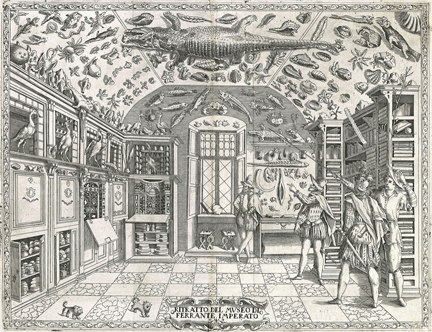
One of the earliest examples of the Wunderkammer in art is the frontispiece of Ferrante Imperato’s book Dell’Historia Naturale, a self-illustrated informational catalogue of his apothecarian work. This catalogue was the first illustration of a natural history research collection, featuring among the objects represented were stuffed birds and reptiles, fossils, geological samples, and seashells. Pictured in the illustration is Imperato’s son Francesco, who points out specimens to visitors as Imperato himself looks on.
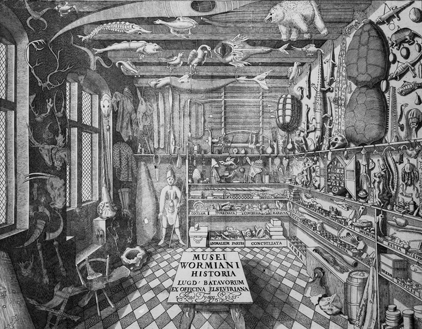
Another piece of documentation and an early example of a modern natural history museum is the frontispiece engraving of the Museum Wormianum, the Wunderkammer belonging to Ole Worm, a physician, linguist, and natural philosopher. The catalogue of his collection was published posthumously in 1655, and illustrates Worm’s extensive collection of animal specimens, anthropological objects, and scientific instruments. Photographer Rosamond Purcell recently set out to recreate the Wormianum with uncanny precision and making substitutions for the more rare or nonexistent objects of the original collection. Worm’s Wunderkammer included such things as the stuffed great auk, a now extinct seabird of which Worm also kept as a pet. Purcell’s meticulously researched instillation called “One Room” includes approximately forty original items from Worm’s collection; it was first exhibited in the Santa Monica Museum of Art, now known as the Institute of Contemporary Art, Los Angeles, and is now on permanent display at the Geological Museum in the Natural History Museum of Denmark.
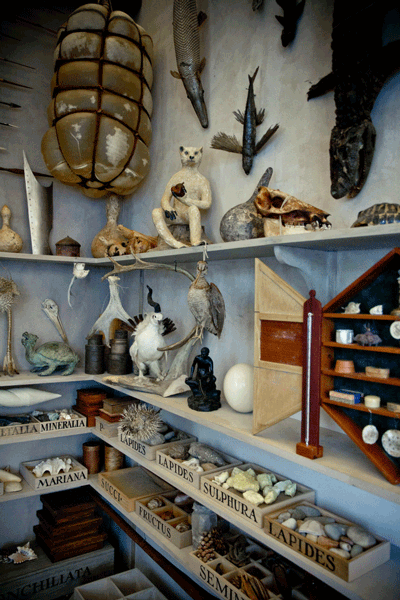
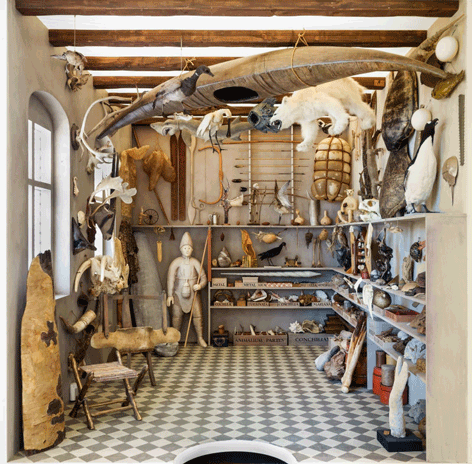
The purpose of a Wunderkammer began to shift in the early 17th century, to a more art-centered collection, when Frans Francken the Younger (1581-1642) and Jan Brueghel the Elder (1568-1625) were the first to paint them, creating the genre of gallery paintings. These types of rooms are sometimes called Kunstkammers (art rooms), a term usually interchangeable in modern English with Wunderkammer, and are depicted in gallery paintings as large rooms with several paintings and sculpture, as well as the typical natural science and cultural artifacts found in a Wunderkammer. The rooms are extravagant and high-ceilinged, and indicate the wealth, means, social standing of the collector, and as the genre began gaining in popularity, the vast maximalism of the paintings themselves came to reflect the exorbitant subject matter.
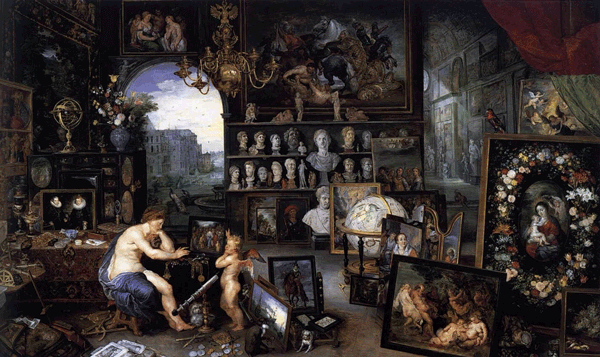
Allegory of Sight (1617-1618) by Jan Brueghel the Elder and Peter Paul Rubens (1577-1640) was one of a series of five paintings meant to represent each of the five senses; this painting depicts the collection of Alberto and Isabel Clara Eugenia, the Habsburg archduke and archduchess. In the painting, Venus and Cupid look over a painting of the Christian story The Healing of the Blind Man, directly referencing sight, but sight here is allegorically represented by the multitude of visualizations in the extensive collection of paintings. The trappings of elite collectors, such as a Persian carpet, exotic peacocks, and the large globe present within the composition are symbolic of a cosmopolitan lifestyle, signifying the well-travelled and worldly couple to whom the collection belongs.
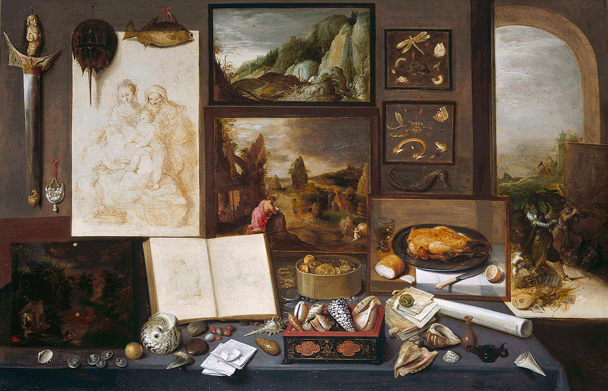
Frans Francken the Younger’s seminal painting The Cabinet of a Collector (1617) features depictions of religious paintings as well as drawings of Michelangelo’s Sistine ceiling and specimen paintings of animal anomalies. The seashells, stones, and stuffed fish on the table represent the traditional naturalia and exotica of this collection, as well as the artificialia represented by the weapons mounted on the wall. Also present in the image are letters and coins, indicating the intelligence and monetary success of the collector. An allegorical scene of ignorance is played out in the background of the painting, as men with donkey heads destroy a pile of scientific objects. This painting as a whole is thought to celebrate the achievements of intellectuals and worldly scholars as contrasted by the acts of ignorance and destruction displayed by the donkey-men. In celebration of intellectualism and building on the trend of featuring prominent contemporary thinkers, Francken painted a similar scene in 1636 called Chamber of Art and Curiosities, in which renowned cartographer Abraham Ortelius (1527-1598) is represented in the small portraits to the left of the painting. In the background three men are depicted standing over a large map.
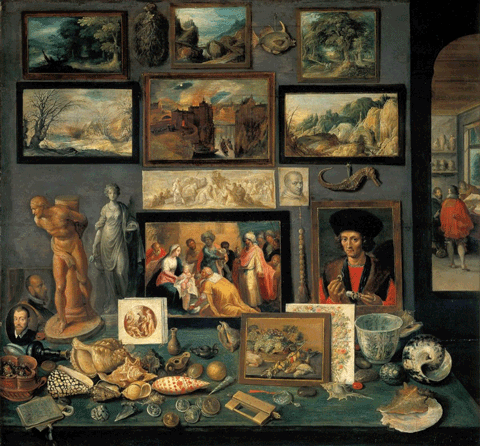
The use of the gallery painting and the Kunstkammer within the next century came to reveal itself as a more pompous tool for the expression of social status, in exchange for the educational purposes of the traditional cabinet of curiosity. Grandiose paintings like The Gallery of Cornelis van der Geest (1628), painted by Willem van Haecht (1593-1637) while in the employ of van der Geest, are focused mainly on the wealth and status of the collector, rather than the collection itself. Van Haecht’s painting depicts a meeting of notable thinkers debating art and collectively agreeing on which artists were to be deemed historically important. Similarly, the painting The Archduke Leopold Wilhelm in His Gallery at Brussels by David Teniers the Younger (1610-1690), painted in 1651 represented the wealth and importance of the collector, who was able to exhibit his acquisitions to men of high power from around the world.
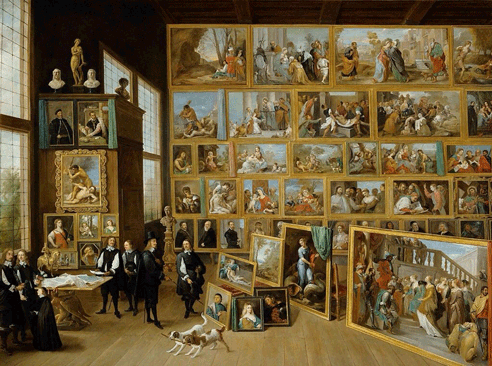
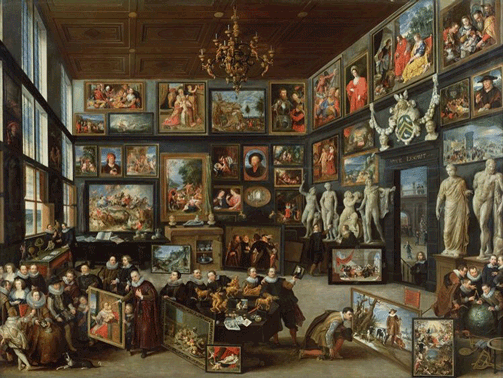
Since its late-16th-century inception as a means to indulge intellectual curiosities, to its peak in the early 18th-century and transition to a symbol of power and privilege, the Wunderkammer has been adapted back to its original purpose in its modern iteration. Though the practice of painting the Wunderkammer has dematerialized, the creation and maintenance of a curiosity collection has been adapted to suit public accessibility and once again engage the mind. For those interested in visiting a Wunderkammer or starting their own collection, the author recommends Skull Store in Toronto, a subsidiary of the Prehistoria Natural History Centre and Educated Earth, and the Wagner Free Institute of Science in Philadelphia.

